Aerosol Retrieval Method Using Multi-Angle Data from GF-5 02 DPC over the Jing–Jin–Ji Region
Abstract
:1. Introduction
2. Method
- (1)
- The AOD of the default aerosol model (seen in the next chapter) from DPC data was retrieved at the nadir angle, which aimed to maintain consistency with the viewing geometry of the 8-Day MOD09 product, and a and b were received for every pixel in Chapter IV;
- (2)
- Using Equation (2), the reflectances at other angles after AC were received;
- (3)
- Using Equation (6), the reflectances were normalized, and, using Equation (7), the variance, , was calculated;
- (4)
- If was less than 2, the result was output for default aerosol model. If not, was calculated for other aerosol models, and the minimum of was output.

3. Aerosol Model
- BC’s proportion (BC%) varies from 0% to 15% in 5% increments (0%, 5%, 10%, 15%);
- WASO’s proportion (WASO%) ranges from 10% to 100% in 30% increments (10%, 40%, 70%, 100%), as well as 100% in adjustment to 1-BC% when BC > 0%;
- Dust proportion is defined as 1-BC%-WASO%.
4. Surface Reflectance Analysis
5. Retrieval Experiments and Validation
6. Discussion
6.1. Calibration
6.2. Spectral Response Function (SRF)
6.3. The Variance Threshold
7. Conclusions
Author Contributions
Funding
Data Availability Statement
Acknowledgments
Conflicts of Interest
References
- Kaufman, Y.J.; Tanré, D.; Remer, L.A.; Vermote, E.F.; Chu, A.; Holben, B.N. Operational remote sensing of tropospheric aerosol over land from EOS moderate resolution imaging spectroradiometer. J. Geophys. Res. 1997, 102, 17051–17067. [Google Scholar] [CrossRef]
- Levy, R.C.; Remer, L.A.; Mattoo, S.; Vermote, E.F.; Kaufman, Y.J. Second-generation operational algorithm: Retrieval of aerosol properties over land from inversion of Moderate Resolution Imaging Spectroradiometer spectral reflectance. J. Geophys. Res. D Atmos. 2007, 112, D13211. [Google Scholar] [CrossRef]
- Li, Y.J.; Xue, Y.; de Leeuw, G.; Li, C.; Yang, L.K.; Hou, T.T.; Marir, F. Retrieval of aerosol optical depth and surface reflectance over land from NOAA AVHRR data. Remote Sens. Environ. 2013, 133, 1–20. [Google Scholar] [CrossRef]
- Mei, L.L.; Rozanov, V.; Vountas, M.; Burrows, J.P.; Levy, R.C.; Lotz, W. Retrieval of aerosol optical properties using MERIS observations: Algorithm and some first result. Remote Sens. Environ. 2017, 197, 125–140. [Google Scholar] [CrossRef]
- Xue, Y.; He, X.W.; de Leeuw, G.; Mei, L.L.; Che, Y.H.; Rippin, W.; Guang, J.; Hu, Y.C. Long-time series aerosol optical depth retrieval from AVHRR data over land in North China and Central Europe. Remote Sens. Environ. 2017, 198, 471–489. [Google Scholar] [CrossRef]
- Wang, Z.T.; Ma, P.F.; Chen, H.; Zhang, Y.H.; Zhang, L.J.; Li, S.S.; Li, Q.; Chen, L.F. Aerosol retrieval in the autumn and winter from the red and 2.12 μm bands of MODIS. Trans. Geosci. Remote Sens. 2019, 57, 2372–2380. [Google Scholar] [CrossRef]
- Sun, L.; Sun, C.; Liu, Q.; Zhong, B. Aerosol optical depth retrieval by HJ-1/CCD supported by MODIS surface reflectance data. Sci. China Earth Sci. 2010, 53, 74–80. [Google Scholar] [CrossRef]
- Bao, F.W.; Gu, X.F.; Cheng, T.H.; Wang, Y.; Guo, H.; Chen, H.; Wei, X.; Xiang, K.S.; Li, Y.N. High-Spatial-Resolution Aerosol Optical Properties Retrieval Algorithm Using Chinese High-Resolution Earth Observation Satellite I. IEEE Trans. Geosci. Remote Sens. 2016, 54, 5544–5552. [Google Scholar] [CrossRef]
- Ge, B.Y.; Li, Z.Q.; Liu, L.; Yang, L.K.; Chen, X.F.; Hou, W.Z.; Zhang, Y.; Li, Q.H.; Li, L.; Qie, L.L. A Dark Target Method for Himawari-8/AHI Aerosol Retrieval: Application and Validation. IEEE Trans. Geosci. Remote Sens. 2019, 57, 381–394. [Google Scholar] [CrossRef]
- Jackson, J.M.; Liu, H.; Laszlo, I.; Kondragunta, S.; Remer, L.A.; Huang, J.; Huang, H.C. Suomi-NPP VIIRS aerosol algorithms and data products. J. Geophys. Res. Atmos. 2013, 118, 12673–12689. [Google Scholar] [CrossRef]
- Jin, S.K.; Zhang, M.; Ma, Y.; Gong, W.; Chen, C.; Yang, L.; Hu, X.; Liu, B.; Chen, N.; Du, B.; et al. Adapting the Dark Target Algorithm to Advanced MERSI Sensor on the FengYun-3-D Satellite: Retrieval and Validation of Aerosol Optical Depth Over Land. IEEE Trans. Geosci. Remote Sens. 2021, 59, 8781–8797. [Google Scholar] [CrossRef]
- Hsu, N.; Jeong, M.J.; Bettenhausen, C.; Sayer, A.M.; Hansell, R.; Seftor, C.S.; Huang, J.; Tsay, S.C. Enhanced deep blue aerosol retrieval algorithm: The second generation. J. Geophys. Res. Atmos. 2013, 118, 9296–9315. [Google Scholar] [CrossRef]
- Hsu, N.C.; Lee, J.; Sayer, A.M.; Carletta, N.; Chen, S.H.; Tucker, C.J.; Holben, B.N.; Tsay, S.C. Retrieving near-global aerosol loading over land and ocean from AVHRR. J. Geophys. Res. Atmos. 2017, 122, 9968–9989. [Google Scholar] [CrossRef]
- Mishra, M.K. Retrieval of Aerosol Optical Depth from INSAT-3D Imager over Asian Landmass and Adjoining Ocean: Retrieval Uncertainty and Validation. J. Geophys. Res. Atmos. 2018, 123, 5484–5508. [Google Scholar] [CrossRef]
- Sun, K.; Chen, X.L.; Zhu, Z.M.; Zhang, T.H. High Resolution Aerosol Optical Depth Retrieval Using Gaofen-1 WFV Camera Data. Remote Sens. 2017, 9, 89–107. [Google Scholar] [CrossRef]
- Lyapustin, A.; Martonchik, J.; Wang, Y.; Laszlo, I.; Korkin, S. Multi-Angle Implementation of Atmospheric Correction (MAIAC): Part 1. Radiative Transfer Basis and Look-Up Tables. J. Geophys. Res. 2011, 116, D03210. [Google Scholar] [CrossRef]
- Diner, D.J.; Martonchik, J.V.; Kahn, R.; Pinty, B.; Gobron, N.; Nelson, D.L.; Holben, B.N. Using Angular and Spectral Shape Similarity Constraints to Improve MISR Aerosol and Surface Retrievals over Land. Remote Sens. Environ. 2005, 94, 155–171. [Google Scholar] [CrossRef]
- Wang, Y.Q.; Jiang, X.; Yu, B.; Jiang, M. A Hierarchical Bayesian Approach for Aerosol Retrieval Using MISR Data. J. Am. Stat. Assoc. 2013, 108, 483–493. [Google Scholar] [CrossRef]
- Shi, S.Y.; Cheng, T.H.; Gu, X.F.; Chen, H.; Guo, H.; Wang, Y.; Bao, F.W.; Xu, B.; Wang, W.N.; Zuo, X.; et al. Synergy of MODIS and AATSR for better retrieval of aerosol optical depth and land surface directional reflectance. Remote Sens. Environ. 2017, 195, 130–141. [Google Scholar] [CrossRef]
- Veefkind, J.P.; de Leeuw, G.; Durkee, P. Retrieval of aerosol optical depth over land using two-angle view satellite radiometry during TARFOX. Geophys. Res. Lett. 1998, 25, 3135–3138. [Google Scholar] [CrossRef]
- Herman, M.; Deuzé, J.L.; Devaux, C.; Goloub, P.; Bréon, F.M.; Tanré, D. Remote sensing of aerosols over land surfaces including polarization measurements and application to POLDER measurements. J. Geophys. Res. 1997, 102, 17039–17049. [Google Scholar] [CrossRef]
- Deuzé, J.L.; Bréon, F.M.; Devaux, C.; Goloub, P.H.; Herman, M.; Lafrance, B.; Maignan, F.; Marchand, A.; Nadal, F.; Perry, G.; et al. Remote sensing of aerosols over land surfaces from POLDER-ADEOS 1 polarized measurements. J. Geophys. Res. 2001, 106, 4913–4926. [Google Scholar] [CrossRef]
- Russell, P.B.; Kacenelenbogen, M.; Livingston, J.M.; Hasekamp, O.P.; Burton, S.P.; Schuster, G.L.; Johnson, M.S.; Knobelspiesse, K.D.; Redemann, J.; Ramachandran, S.; et al. A multiparameter aerosol classification method and its application to retrievals from spaceborne polarimetry. J. Geophys. Res. Atmos. 2014, 119, 9838–9863. [Google Scholar] [CrossRef]
- Fu, G.; Hasekamp, O. Retrieval of aerosol microphysical and optical properties over land using a multimode approach. Atmos. Meas. Tech. 2018, 11, 6627–6650. [Google Scholar] [CrossRef]
- Dubovik, O.; Herman, M.; Holdak, A.; Lapyonok, T.; Tanré, D.; Deuzé, J.L.; Ducos, F.; Sinyuk, A.; Lopatin, A. Statistically optimized inversion algorithm for enhanced retrieval of aerosol properties from spectral multi-angle polarimetric satellite observations. Atmos. Meas. Tech. 2011, 4, 975–1018. [Google Scholar] [CrossRef]
- Ou, Y.; Li, L.; Li, Z.; Zhang, Y.; Dubovik, O.; Derimian, Y.; Chen, C.; Fuertes, D.; Xie, Y.; Lopatin, A.; et al. Spatio-Temporal Variability of Aerosol Components, Their Optical and Microphysical Properties over North China during Winter Haze in 2012, as Derived from POLDER/PARASOL Satellite Observations. Remote Sens. 2021, 13, 22. [Google Scholar] [CrossRef]
- Li, L.; Dubovik, O.; Derimian, Y.; Schuster, G.L.; Lapyonok, T.; Litvinov, P.; Ducos, F.; Fuertes, D.; Chen, C.; Li, Z.; et al. Retrieval of aerosol components directly from satellite and ground-based measurements. Atmos. Chem. Phys. 2019, 19, 13409–13443. [Google Scholar] [CrossRef]
- Chen, C.; Dubovik, O.; Fuertes, D.; Litvinov, P.; Lapyonok, T.; Lopatin, A.; Ducos, F.; Derimian, Y.; Herman, M.; Tanré, D.; et al. Validation of GRASP algorithm product from POLDER/PARASOL data and assessment of multi-angular polarimetry potential for aerosol monitoring. Earth Syst. Sci. Data 2020, 12, 3573–3620. [Google Scholar] [CrossRef]
- Di Noia, A.; Hasekamp, O.P.; Wu, L.; van Diedenhoven, B.; Cairns, B.; Yorks, J.E. Combined neural network/Phillips–Tikhonov approach to aerosol retrievals over land from the NASA research scanning polarimeter. Atmos. Meas. Techn. 2017, 10, 4235–4252. [Google Scholar] [CrossRef]
- Chen, X.; Wang, J.; Gomes, J.; Dubovik, O.; Yang, P.; Saito, M. Analytical prediction of scattering properties of spheroidal dust particles with machine learning. Geophys. Res. Lett. 2022, 49, 49. [Google Scholar] [CrossRef]
- Kang, Y.; Kim, M.; Kang, E.; Cho, D.; Im, J. Improved retrievals of aerosol optical depth and fine mode fraction from GOCI geostationary satellite data using machine learning over East Asia. ISPRS J. Photogramm. Remote Sens. 2022, 183, 253–268. [Google Scholar] [CrossRef]
- Tao, M.; Chen, J.; Xu, X.; Man, W.; Xu, L.; Wang, L.; Chen, L.; Wang, Y.; Wang, J.; Fan, M.; et al. A robust and flexible satellite aerosol retrieval algorithm for multi-angle polarimetric measurements with physics-informed deep learning method. Remote Sens. Environ. 2023, 297, 113763. [Google Scholar] [CrossRef]
- Li, Z.; Hou, W.; Hong, J.; Zheng, F.; Luo, D.; Wang, J.; Gu, X.; Qiao, Y. Directional Polarimetric Camera (DPC): Monitoring aerosol spectral optical properties over land from satellite observation. J. Quant. Spectrosc. Radiat. Transf. 2018, 218, 21–37. [Google Scholar] [CrossRef]
- Huang, H.-L.; Ti, R.-F.; Zhang, D.-Y.; Fang, W.; Sun, X.-B.; Yi, W.-N. Inversion of aerosol optical depth over land from directional polarimetric camera onboard Chinese Gaofen-5 satellite. J. Infrared Millim. Waves 2020, 39, 454–461. [Google Scholar]
- Ge, B.Y.; Li, Z.; Chen, C.; Hou, W.; Xie, Y.; Zhu, S.; Qie, L.; Zhang, Y.; Li, K.; Xu, H.; et al. An Improved Aerosol Optical Depth Retrieval Algorithm for Multiangle Directional Polarimetric Camera (DPC). Remote Sens. 2022, 14, 25. [Google Scholar] [CrossRef]
- Fang, L.; Hasekamp, O.; Fu, G.; Gong, W.; Wang, S.; Wang, W.; Han, Q.; Tang, S. Retrieval of Aerosol Optical Properties over Land Using an Optimized Retrieval Algorithm Based on the Directional Polarimetric Camera. Remote Sens. 2022, 14, 20. [Google Scholar] [CrossRef]
- Jin, S.K.; Ma, Y.; Chen, C.; Dubovik, O.; Hong, J.; Liu, B.; Gong, W. Performance evaluation for retrieving aerosol optical depth from the Directional Polarimetric Camera (DPC) based on the GRASP algorithm. Atmos. Meas. Tech. 2022, 15, 4323–4337. [Google Scholar] [CrossRef]
- Li, L.; Che, H.; Zhang, X.; Chen, C.; Chen, X.; Gui, K.; Liang, Y.; Wang, F.; Derimian, Y.; Fuertes, D.; et al. A satellite-measured view of aerosol component content and optical property in a haze-polluted case over North China Plain. Atmos. Res. 2022, 266, 11. [Google Scholar] [CrossRef]
- Zhang, R.; Zhou, W.; Chen, H.; Zhang, L.; Zhang, L.; Ma, P.; Zhao, S.; Wang, Z. Aerosol Information Retrieval from GF-5B DPC Data over North China Using the Dark Dense Vegetation Algorithm. Atmosphere 2023, 14, 241. [Google Scholar] [CrossRef]
- Vermote, E.; Tanre, D.; Deuzé, J.L.; Herman, M.; Morcrette, J.J. Second simulation of the satellite signal in the solar spectrum: An overview. IEEE Trans. Geosci. Remote Sens. 1997, 35, 675–686. [Google Scholar] [CrossRef]
- Zhang, Y.M.; Chen, H.; Wang, Z.T. Terrestrial aerosol retrieval over Beijing from Chinese GF-1 data based on the blue/red correlation. Remote Sens. Lett. 2021, 12, 219–228. [Google Scholar] [CrossRef]
- Kotchenova, S.Y.; Vermote, E.F.; Matarrese, R.; Klemm, F.J., Jr. Validation of a Vector Version of the 6S Radiative Transfer Code for Atmospheric Correction of Satellite Data. Part I: Path radiance. Appl. Opt. 2006, 45, 6762–6774. [Google Scholar] [CrossRef] [PubMed]
- Wei, P.; Li, Z.Q.; Wang, Y.; Xie, Y.S.; Zhang, Y.; Xu, H. Remote sensing estimation of aerosol composition and radiative effects in haze days. J. Remote Sens. 2013, 17, 1021–1031. [Google Scholar]
- Levy, R.C.; Munchak, L.A.; Mattoo, S.; Patadia, F.; Remer, L.A.; Holz, R.E. Towards a long-term global aerosol optical depth record: Applying a consistent aerosol retrieval algorithm to MODIS and VIIRS-observed reflectance. Atmos. Meas. Tech. 2015, 8, 4083–4110. [Google Scholar] [CrossRef]
- Sayer, A.M.; Munchak, L.A.; Hsu, N.C.; Levy, R.C.; Bettenhausen, C.; Jeong, M.-J. MODIS Collection 6 aerosol products: Comparison between Aqua’s e-Deep Blue, Dark Target, and “merged” data sets, and usage recommendations. J. Geophys. Res. Atmos. 2014, 119, 13965–13989. [Google Scholar] [CrossRef]
- Levy, R.C.; Mattoo, S.; Munchak, L.A.; Remer, L.A.; Sayer, A.M.; Patadia, F.; Hsu, N.C. The Collection 6 MODIS aerosol products over land and ocean. Atmos. Meas. Tech. 2013, 6, 2989–3034. [Google Scholar] [CrossRef]
- Sayer, A.M.; Hsu, N.C.; Bettenhausen, C.; Jeong, M.-J.; Meister, G. Effect of MODIS Terra radiometric calibration improvements on Collection 6 Deep Blue aerosol products: Validation and Terra/Aqua consistency. J. Geophys. Res. Atmos. 2015, 120, 12157–12174. [Google Scholar] [CrossRef]
- Dubovik, O.; Fuertes, D.; Litvinov, P.; Lopatin, A.; Lapyonok, T.; Doubovik, I.; Xu, F.; Ducos, F.; Chen, C.; Torres, B.; et al. A Comprehensive Description of Multi-Term LSM for Applying Multiple a Priori Constraints in Problems of Atmospheric Remote Sensing: GRASP Algorithm, Concept, and Applications. Front. Remote Sens. 2021, 2, 706851. [Google Scholar] [CrossRef]
- Angstrom, A. The parameters of atmospheric turbidity. Tellus 1964, 16, 64–75. [Google Scholar] [CrossRef]
- Zhu, S.; Li, Z.; Qie, L.; Xu, H.; Ge, B.; Xie, Y.; Qiao, R.; Xie, Y.; Hong, J.; Meng, B.; et al. In-Flight Relative Radiometric Calibration of a Wide Field of View Directional Polarimetric Camera Based on the Rayleigh Scattering over Ocean. Remote Sens. 2022, 14, 1211. [Google Scholar] [CrossRef]
- Lei, X.; Liu, Z.; Tao, F.; Dong, H.; Hou, W.; Xiang, G.; Qie, L.; Meng, B.; Li, C.; Chen, F.; et al. Data Comparison and Cross-Calibration between Level 1 Products of DPC and POSP Onboard the Chinese GaoFen-5(02) Satellite. Remote Sens. 2023, 15, 1933. [Google Scholar] [CrossRef]
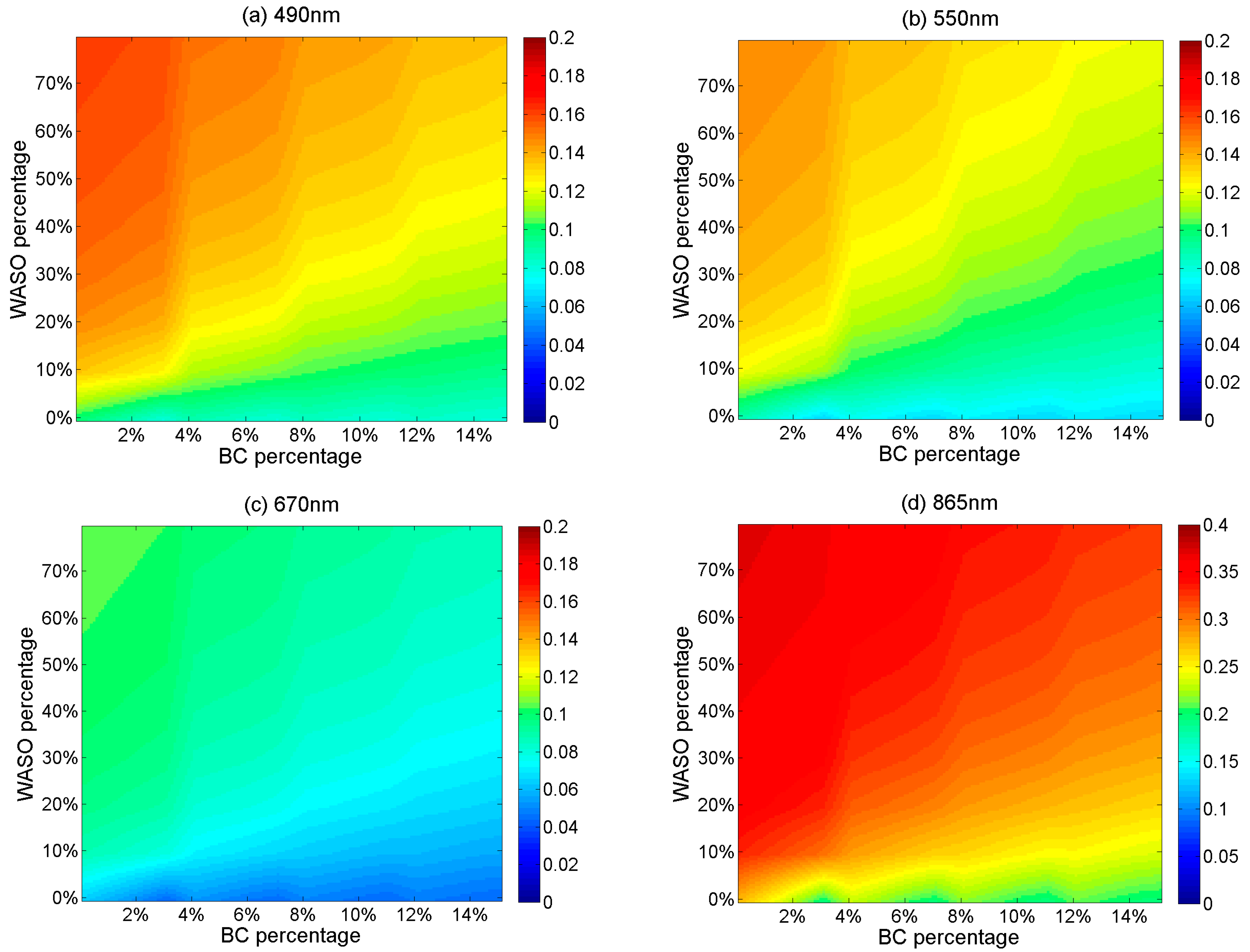



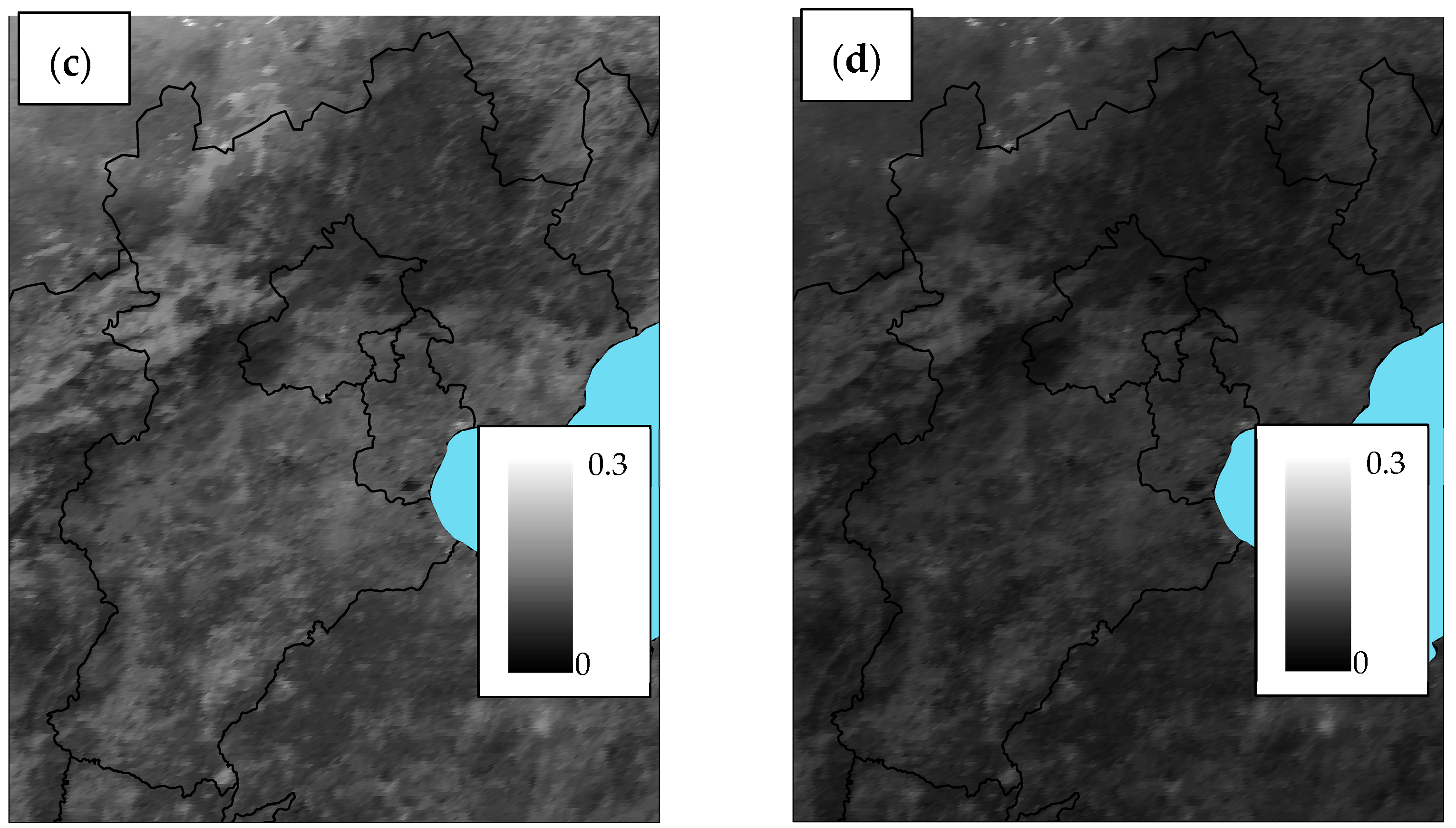

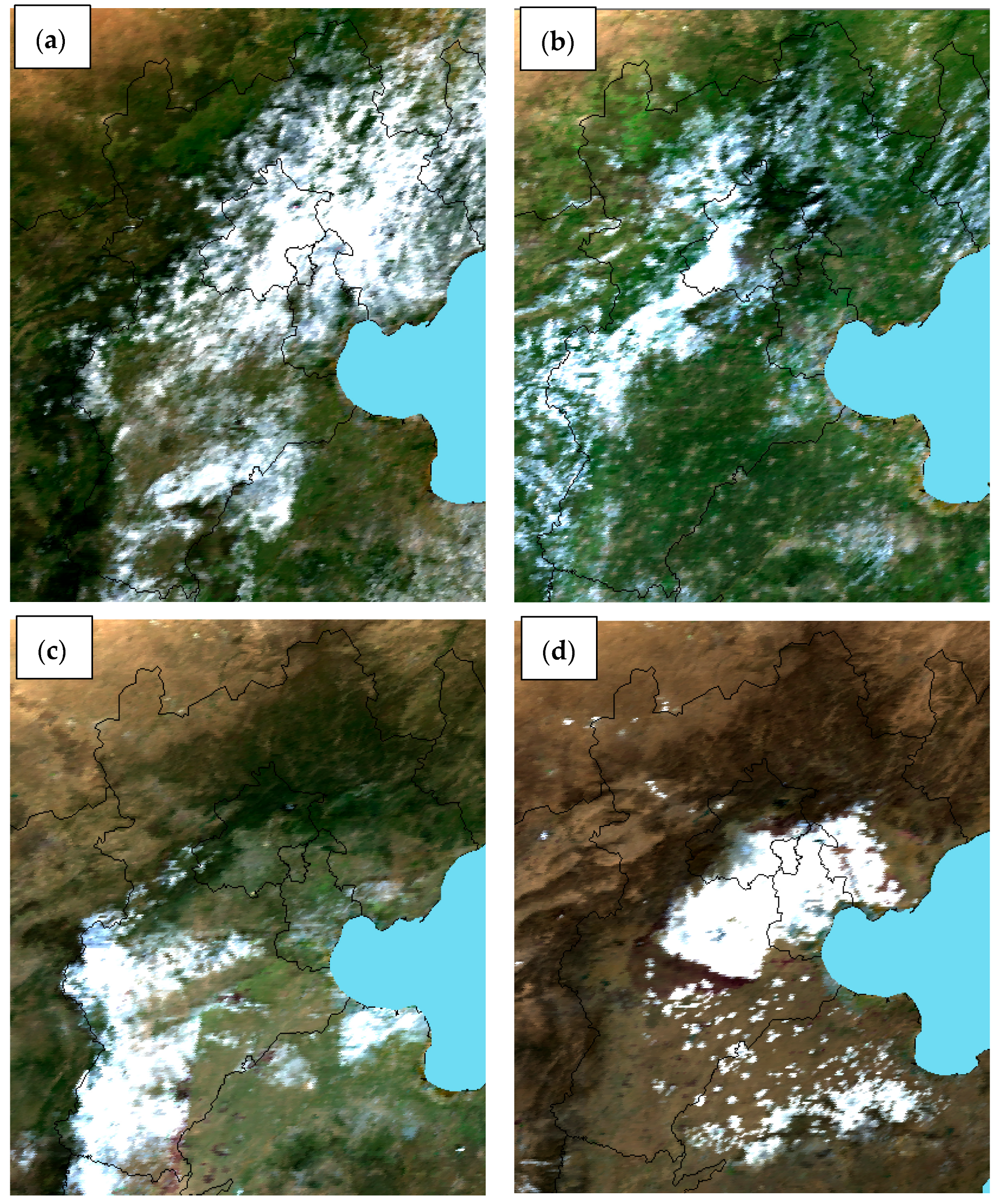
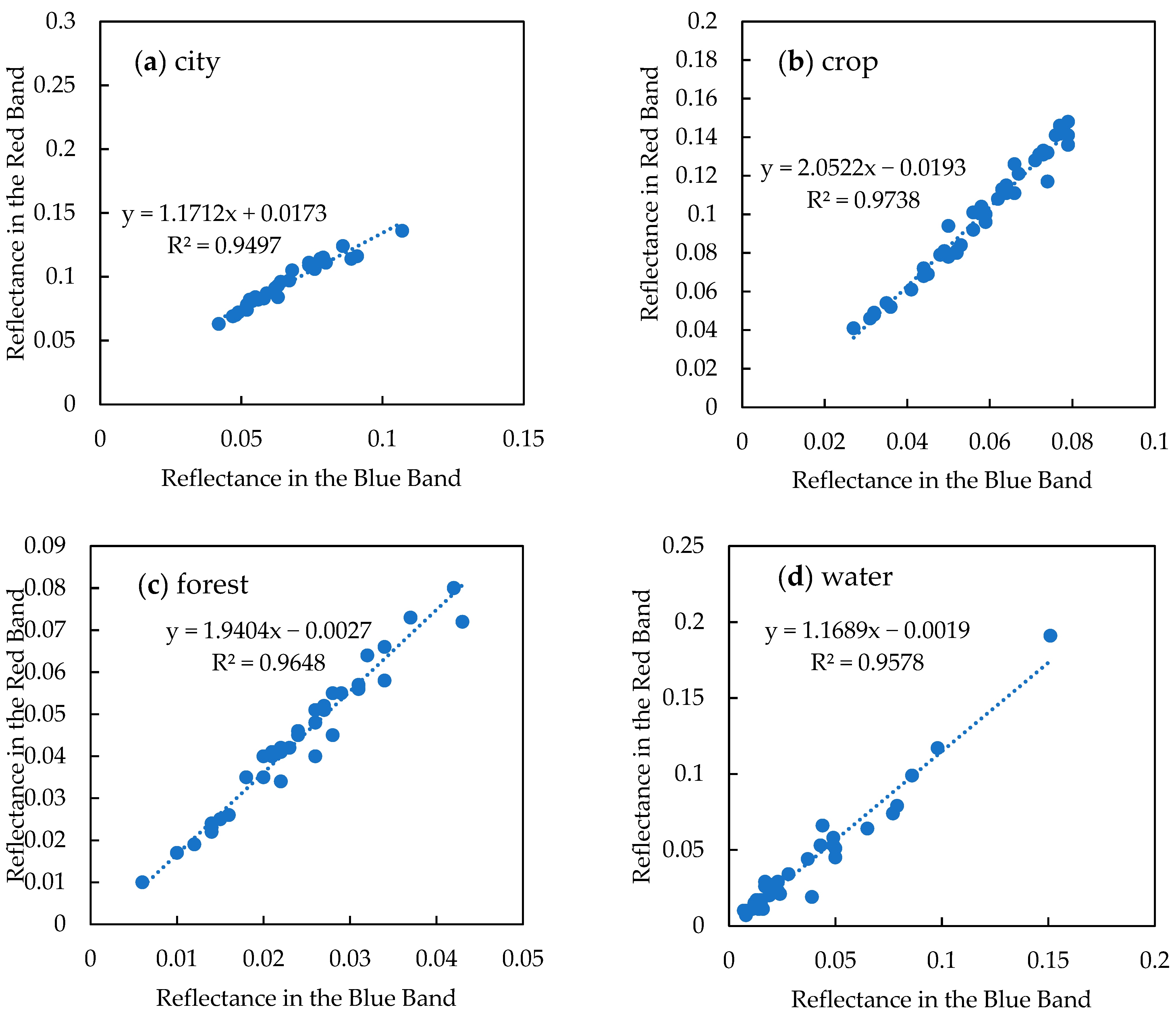

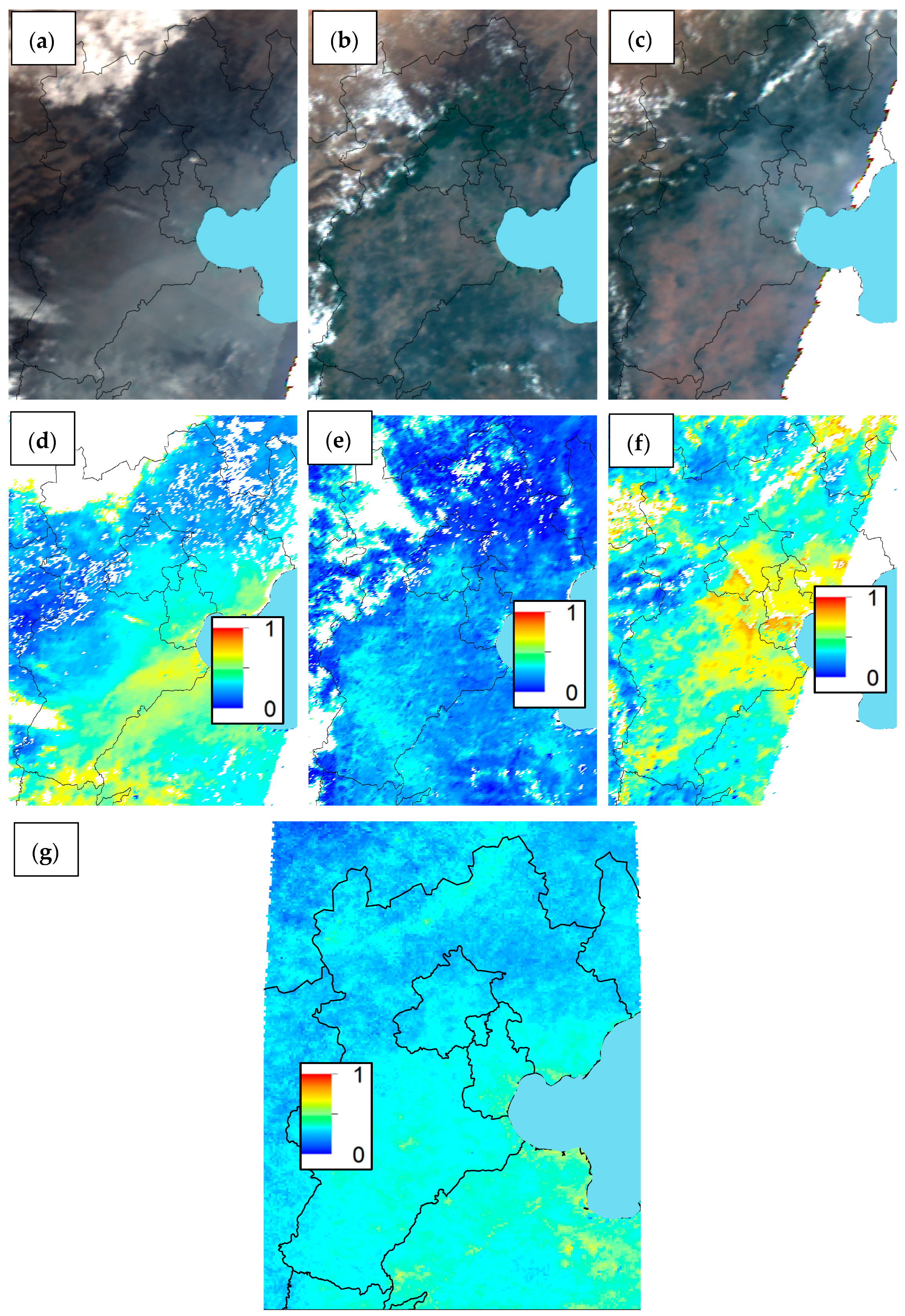
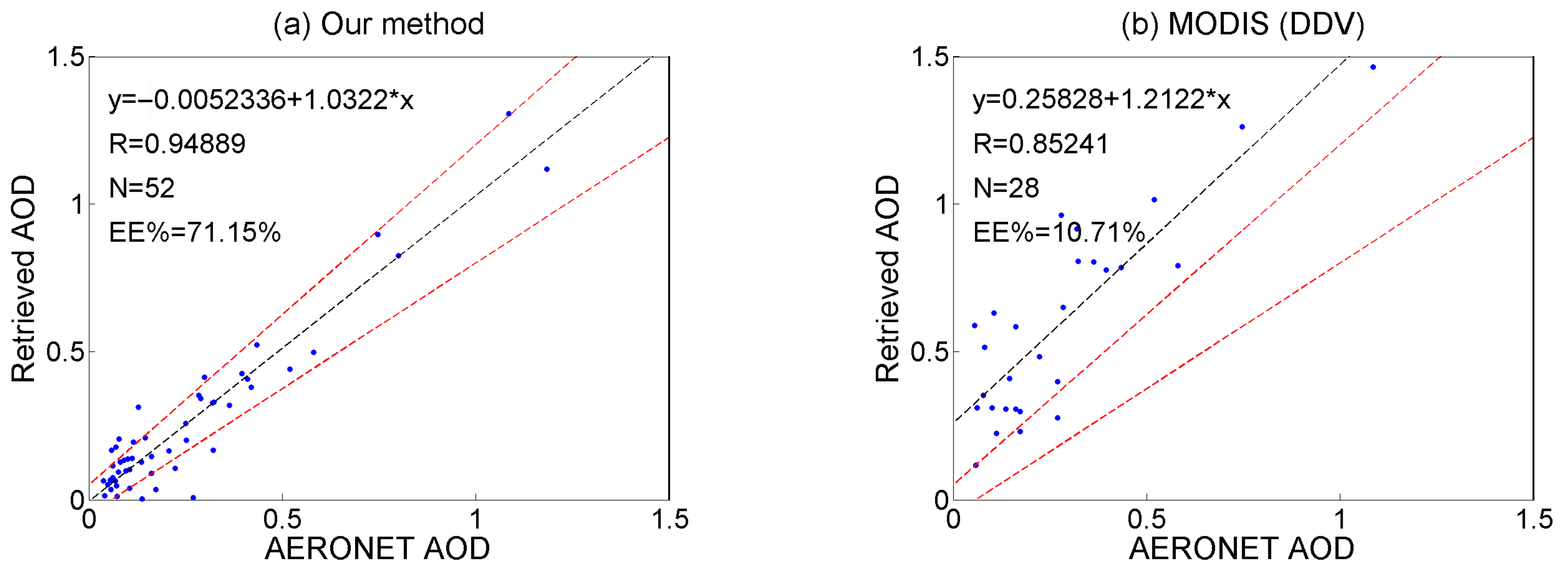


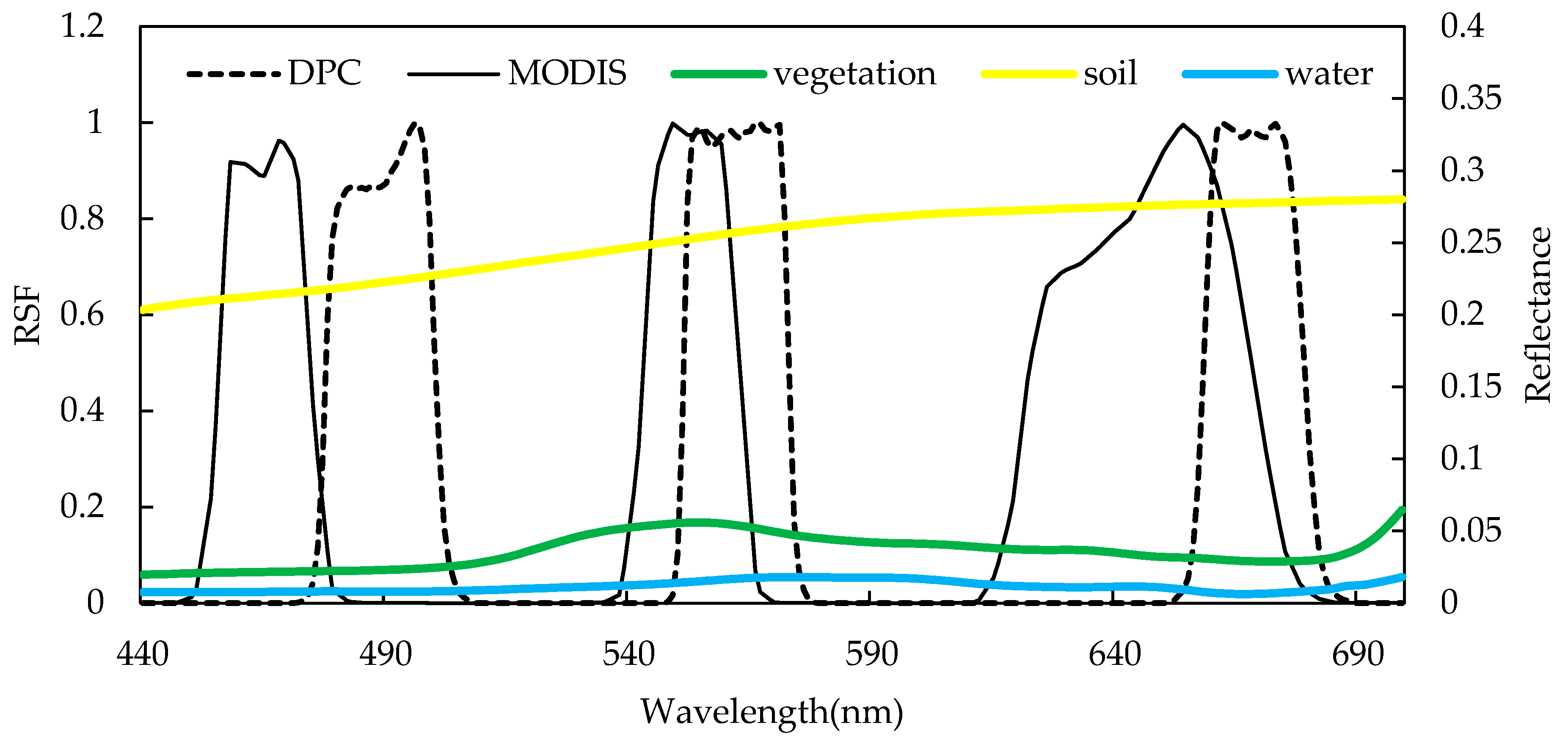

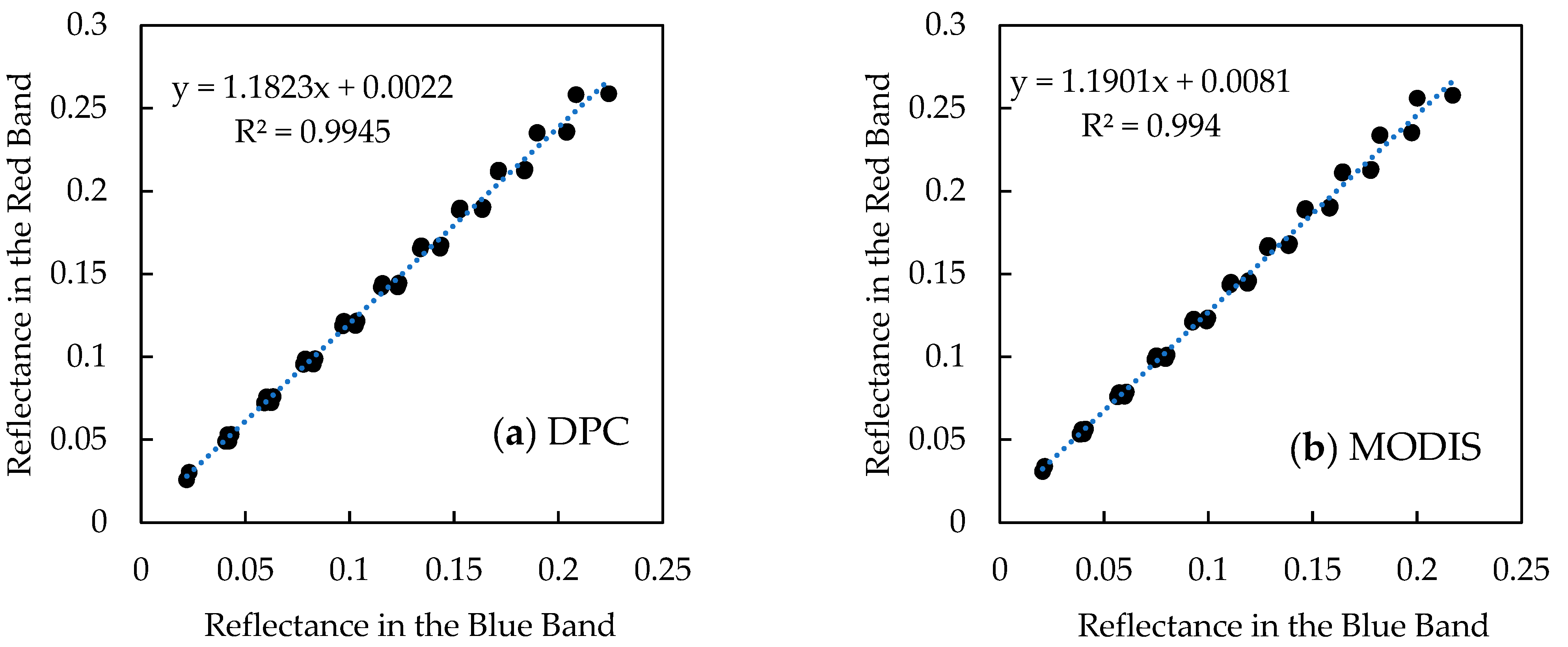
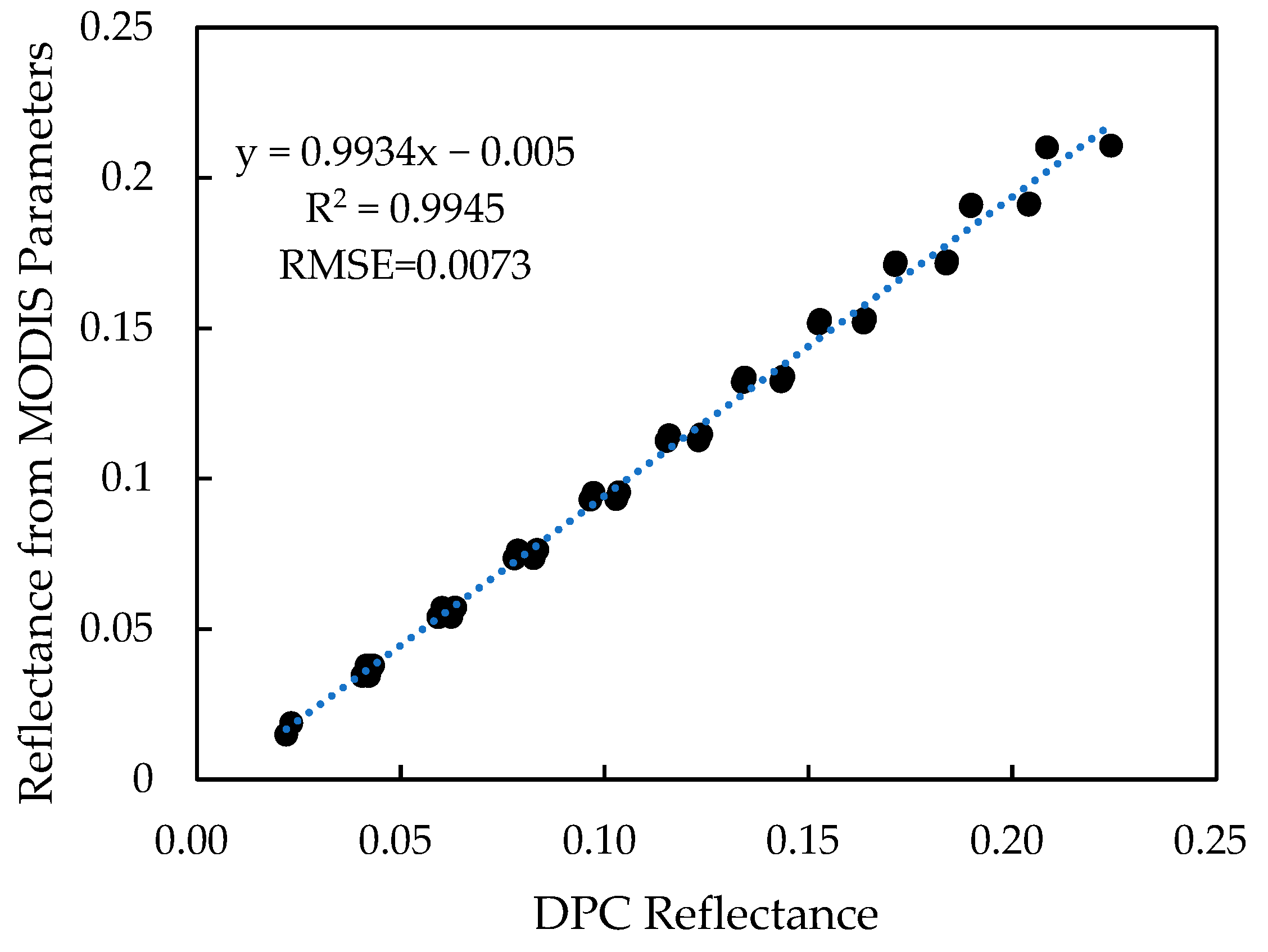
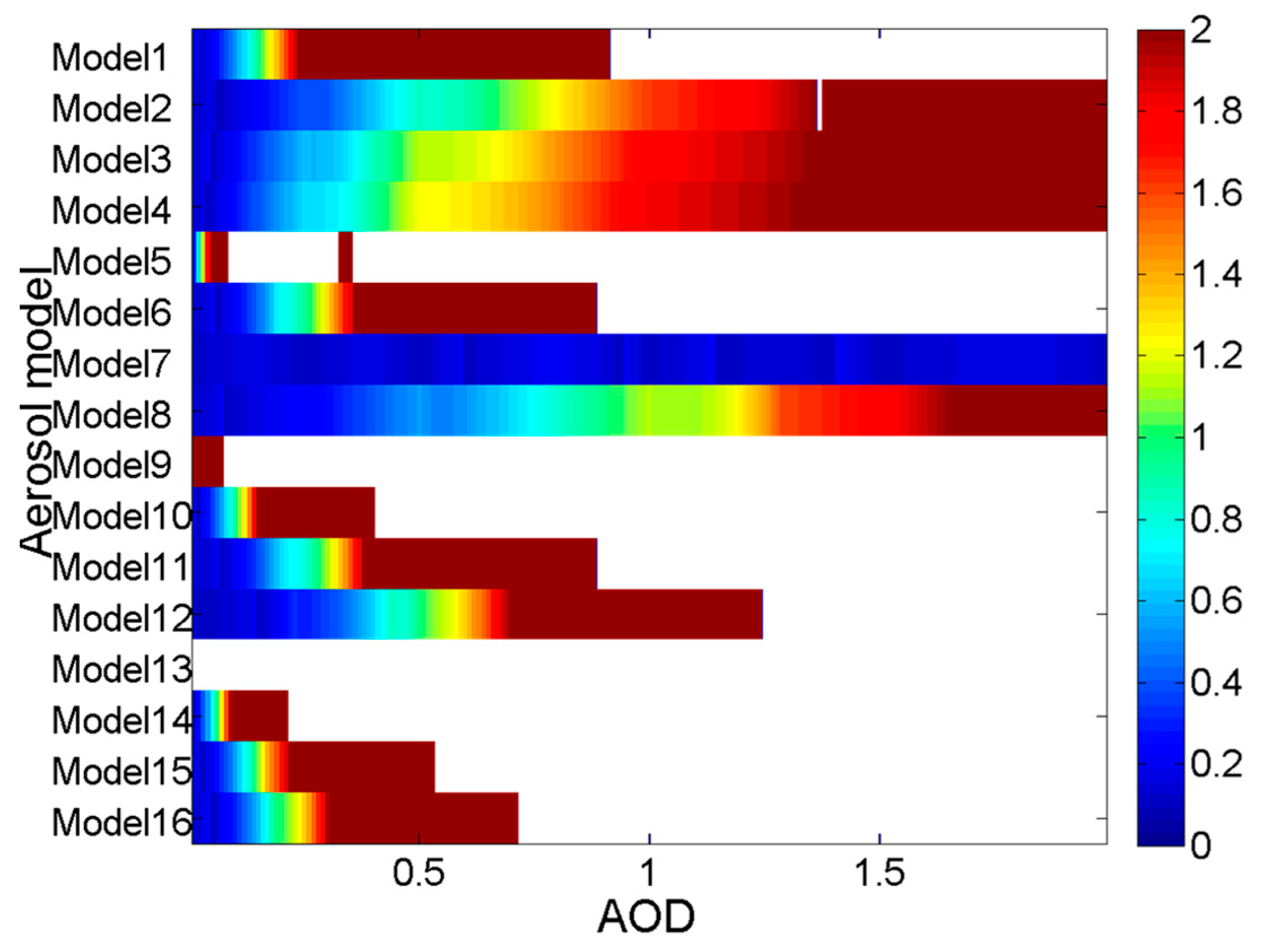
| No. | WASO | BC | Dust |
|---|---|---|---|
| 1 | 10% | 0% | 90% |
| 2 | 40% | 0% | 60% |
| 3 | 70% | 0% | 30% |
| 4 | 100% | 0% | 0% |
| 5 | 10% | 5% | 85% |
| 6 | 40% | 5% | 55% |
| 7 | 70% | 5% | 25% |
| 8 | 95% | 5% | 0% |
| 9 | 10% | 10% | 80% |
| 10 | 40% | 10% | 50% |
| 11 | 70% | 10% | 20% |
| 12 | 90% | 10% | 0% |
| 13 | 10% | 15% | 75% |
| 14 | 40% | 15% | 45% |
| 15 | 70% | 15% | 15% |
| 16 | 85% | 15% | 0% |
| City | Crop | Forest | Lake | |
|---|---|---|---|---|
| Red vs. NIR | 0.757 | −0.731 | −0.520 | 0.891 |
| Red vs. blue | 0.975 | 0.987 | 0.982 | 0.979 |
| Red vs. green | 0.985 | 0.964 | 0.626 | 0.946 |
| NIR vs. blue | 0.801 | −0.654 | −0.389 | 0.901 |
| NIR vs. green | 0.843 | −0.566 | 0.299 | 0.901 |
| Blue vs. green | 0.985 | 0.983 | 0.743 | 0.965 |
Disclaimer/Publisher’s Note: The statements, opinions and data contained in all publications are solely those of the individual author(s) and contributor(s) and not of MDPI and/or the editor(s). MDPI and/or the editor(s) disclaim responsibility for any injury to people or property resulting from any ideas, methods, instructions or products referred to in the content. |
© 2025 by the authors. Licensee MDPI, Basel, Switzerland. This article is an open access article distributed under the terms and conditions of the Creative Commons Attribution (CC BY) license (https://creativecommons.org/licenses/by/4.0/).
Share and Cite
Wang, Z.; Jin, S.; Chen, C.; Liu, Z.; Zhai, S.; Chen, H.; Zhou, C.; Zhang, R.; Li, H. Aerosol Retrieval Method Using Multi-Angle Data from GF-5 02 DPC over the Jing–Jin–Ji Region. Remote Sens. 2025, 17, 1415. https://doi.org/10.3390/rs17081415
Wang Z, Jin S, Chen C, Liu Z, Zhai S, Chen H, Zhou C, Zhang R, Li H. Aerosol Retrieval Method Using Multi-Angle Data from GF-5 02 DPC over the Jing–Jin–Ji Region. Remote Sensing. 2025; 17(8):1415. https://doi.org/10.3390/rs17081415
Chicago/Turabian StyleWang, Zhongting, Shikuan Jin, Cheng Chen, Zhen Liu, Siyao Zhai, Hui Chen, Chunyan Zhou, Ruijie Zhang, and Huayou Li. 2025. "Aerosol Retrieval Method Using Multi-Angle Data from GF-5 02 DPC over the Jing–Jin–Ji Region" Remote Sensing 17, no. 8: 1415. https://doi.org/10.3390/rs17081415
APA StyleWang, Z., Jin, S., Chen, C., Liu, Z., Zhai, S., Chen, H., Zhou, C., Zhang, R., & Li, H. (2025). Aerosol Retrieval Method Using Multi-Angle Data from GF-5 02 DPC over the Jing–Jin–Ji Region. Remote Sensing, 17(8), 1415. https://doi.org/10.3390/rs17081415









